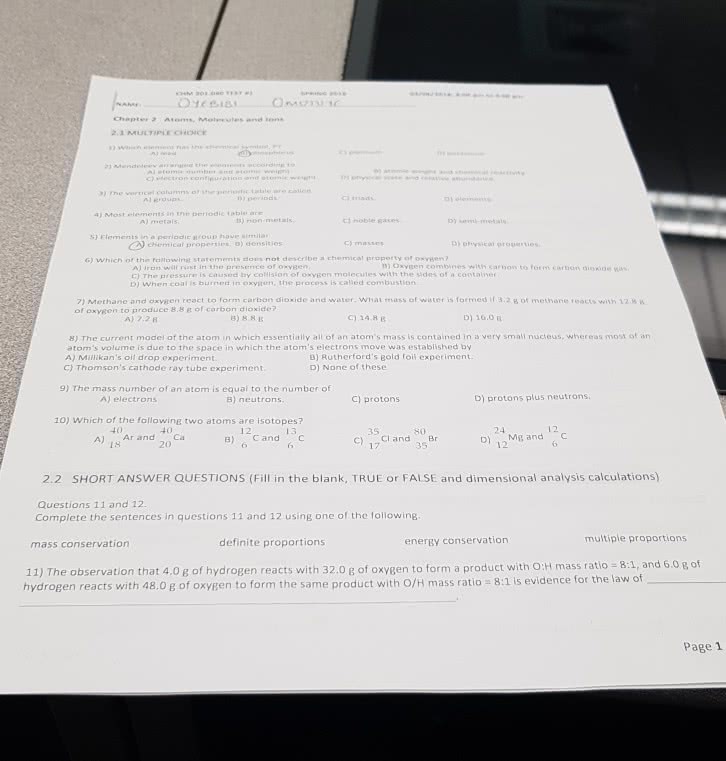01:160:307 Lecture Notes - Lecture 11: Oxidation State, Electronegativity, Hydrogenation

Chapter 11 – Oxidation Reduction Reaction (307 Fall 2019) Page 1
Chapter 11: Oxidation and Reduction Reaction
1. Oxidation and Reduction – definition
2. Catalytic hydrogenation
3. Oxidation reaction of alkenes
4. Oxidation reaction of alcohols
5. Oxidation reaction of amines
1. Oxidation and Reduction – definition
Increase in oxidation number of an atom on the product side is oxidation or and
decrease in oxidation number of an atom on the product side is reduction.
Example:
In organic molecules, oxidation involves a carbon atom to gain bonds to more
electronegative elements, most commonly oxygen. Reduction involves a carbon atom
gains bonds to less electronegative elements, most commonly hydrogen.

Chapter 11 – Oxidation Reduction Reaction (307 Fall 2019) Page 2
2. Catalytic Hydrogenation (Reduction)
a. Catalytic hydrogenation of alkenes
Catalytic hydrogenation of alkenes produces corresponding alkanet the reaction requires
a metal catalyst, usually Pt, Pd, or Ni, and the mechanism involves absorption of hydrogen
to the metal surface followed by absorption of alkenes (heterogeneous catalysis)
• palladium is obtained commercially “supported” on an inert substance, such as
charcoal, (Pd/C). The alkene is usually dissolved in ethanol when Pd/C is used
as the catalyst.
• platinum is used as PtO2, Adams’ catalyst, although it is actually platinum metal
that is the catalyst. Ethanol or acetic acid is used as the solvent for the alkene.
General reaction:
i) It is a syn addition reaction and the reaction is stereoselective.
ii) Catalytic hydrogenation is chemoselective. Other types of compounds containing
multiple bonds, such as ketones, esters, and nitriles, do not react with hydrogen under
the conditions used to hydrogenate alkenes. The examples below show reduction of an
alkene, but the ketone and carboxylic acid groups present remain intact and are not
reduced. Aromatic rings are also not reduced under the conditions used to reduce
alkenes

Chapter 11 – Oxidation Reduction Reaction (307 Fall 2019) Page 3
iii) Heat of hydrogenation (negative) can be used to measure relative stability of alkene
II is more stable than I by 3.4 kcal/mol. More the number of alkyl groups around (C=C)
bond, lower the heat of hydrogenation (lesser exothermic or lesser negative), more the
stability. Trans isomers are more stable than cis.
Order of Stability:
Rankstability1leastexothermicto moltexothermic
onexam Ok DE
Document Summary
Chapter 11: oxidation and reduction reaction: oxidation and reduction definition, catalytic hydrogenation, oxidation reaction of alkenes, oxidation reaction of alcohols, oxidation reaction of amines, oxidation and reduction definition. Increase in oxidation number of an atom on the product side is oxidation or and decrease in oxidation number of an atom on the product side is reduction. In organic molecules, oxidation involves a carbon atom to gain bonds to more electronegative elements, most commonly oxygen. Reduction involves a carbon atom gains bonds to less electronegative elements, most commonly hydrogen. Page 1: catalytic hydrogenation (reduction, catalytic hydrogenation of alkenes. The alkene is usually dissolved in ethanol when pd/c is used as the catalyst: platinum is used as pto2, adams" catalyst, although it is actually platinum metal that is the catalyst. Ethanol or acetic acid is used as the solvent for the alkene. General reaction: it is a syn addition reaction and the reaction is stereoselective, catalytic hydrogenation is chemoselective.


